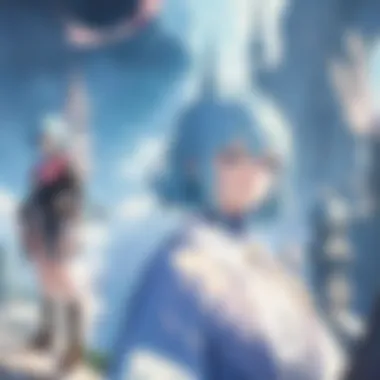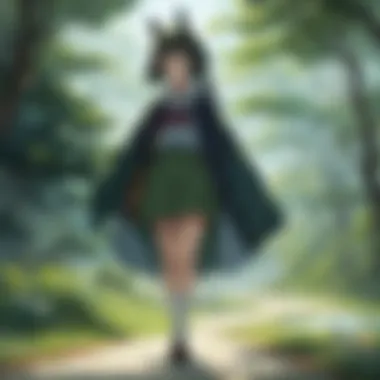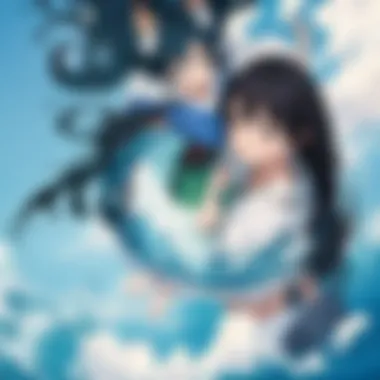In-Depth Exploration of Studio Ghibli's Cinematic Legacy


Intro
Studio Ghibli stands as an iconic name in the realm of animated cinema. Their films are more than mere entertainment; they represent a blend of intricate storytelling, artistic excellence, and deep cultural insights. This analysis aims to honor their work by unpacking the nuances that each film offers. We will explore pivotal themes, artistic styles, and the cultural significance of Studio Ghibli's films while enhancing the appreciation of anime and manga enthusiasts.
The studio, founded in 1985 by Hayao Miyazaki and Isao Takahata, revolutionized how animation can convey complex emotions and narratives. Each film often weaves together powerful messages about nature, humanity, and social issues, setting a standard for filmmakers globally. With memorable stories like "Spirited Away" and "My Neighbor Totoro," Ghibli invites viewers into various worlds, each resonating with its own unique atmosphere and philosophical reflections.
This article will systematically review specific films, examine character development in depth, and even analyze the differences between the anime and any associated manga adaptations. Additionally, we will stay updated with industry news, providing insights on upcoming releases and trends within the animation field.
"The animation produced by Studio Ghibli is not merely art but a crucial discourse that reflects the essence of cultural narratives and shared human experience."
As we proceed, we will also highlight any recent news that may impact Ghibli enthusiasts. Expect discussions that not only celebrate Studio Ghibli's past achievements but also look ahead at what the future holds. This comprehensive analysis is designed to cater to an audience that seeks a detailed understanding of Ghibli's magic, pushing beyond superficial observations into deeper explorations of this fascinating studio.
Overview of Studio Ghibli
Studio Ghibli holds a distinguished place in the world of animation, notable for its artistry, storytelling, and cultural impact. Founded in the late 1980s, the studio has produced a body of work that transcends age and geography. Its films are characterized by rich narratives, lush visuals, and a deep understanding of human emotions. This overview will outline the importance of Studio Ghibli in contemporary cinema and its influence on aspiring filmmakers and animators.
The significance of Studio Ghibli can be traced through several key elements. Firstly, the vibrant films created by the studio have reshaped the global perception of animation. Once viewed primarily as children's entertainment, animation now enjoys recognition as a legitimate artistic medium. The fusion of enchanting visuals with intricate narratives has facilitated a reassessment of the genre, appealing to audiences of all ages. Through films like "Spirited Away" and "My Neighbor Totoro," Ghibli has demonstrated that animation can evoke profound emotional responses and address complex themes.
Moreover, Studio Ghibli's unique storytelling is notable for its focus on nuanced characters, particularly strong female protagonists. This thematic choice resonates deeply within modern discourse on gender representation in media. The studio’s ability to blend traditional Japanese culture with universal themes makes its works both distinctive and relatable.
Lastly, understanding the founding history and key figures behind Studio Ghibli is essential for appreciating its offerings. The legacy of its co-founders, Hayao Miyazaki and Isao Takahata, showcases not only their individual brilliance but also their collaborative synergy. Their philosophies underpin the studio’s approach to animation and storytelling, marking it as a pioneering force.
In essence, this article will comprehensively analyze Studio Ghibli's works, exploring its remarkable films, artistic techniques, and cultural significance. By diving into the details, anime and manga enthusiasts will gain enhanced insight into the depth of Ghibli's contributions to the world of animation.
"Studio Ghibli’s films are not just animated movies; they are compelling stories that engage viewers on multiple levels of interpretation and emotional experience."
Understanding the overview of Studio Ghibli sets the stage for a deeper examination of its founding and history.
List of Studio Ghibli Films
The significance of this section lies in its detailed enumeration of Studio Ghibli's cinematic offerings. This list serves not merely as a catalog, but also as a gateway to understanding the studio’s evolution and impact in the world of animation. Each film carries unique elements that reflect the company's ethos, storytelling prowess, and artistic innovation. Highlighting these films allows for a richer appreciation of Studio Ghibli's contributions to both the genre of animation and global culture. By examining these works, one can draw connections to broader themes and trends in both cinematic history and contemporary storytelling.
Early Works
Castle in the Sky
"Castle in the Sky" stands as a hallmark of Studio Ghibli's initial forays into the animation landscape. Released in 1986, this film introduced audiences to Ghibli’s hallmark blend of adventure and fantastical elements. The narrative centers on two young protagonists searching for a legendary floating island. A key characteristic of "Castle in the Sky" is its richly developed world, which showcases advanced technology intertwined with nature. This reflects a recurring theme in Ghibli films regarding the balance of humanity and the environment. Its beautiful hand-drawn animation set a standard for visual storytelling in the industry, showing how a captivating narrative could thrive alongside breathtaking art. The challenges faced by the characters can resonate with viewers on multiple levels, making it an excellent choice for analysis and appreciation within this article. The film’s unique juxtaposition of technology and nature enhances its relevance in discussions about environmentalism.
Grave of the Fireflies
"Grave of the Fireflies" is a profound narrative that delves into the human condition during times of strife. Released in 1988, this film is often seen as a departure from the more whimsical aspects commonly associated with animation. It tells several stories of two siblings navigating survival during World War II. The primary characteristic of this film is its stark realism and emotional depth, highlighting the trauma of war through the eyes of children. This perspective is powerful and builds empathy, making it a touching choice for inclusion in our analysis. The unique feature of "Grave of the Fireflies" is its demonstration of loss and resilience, which serves as a powerful reminder of the realities of war. This film may contrast with typical Ghibli fare, but it represents a crucial aspect of their filmmaking philosophy, evoking discussions on more serious themes that challenge the audience.
The Golden Era


My Neighbor Totoro
"My Neighbor Totoro" represents a pivotal moment in Studio Ghibli's history, encapsulating the essence of childhood wonder and discovery. Released in 1988, it exudes charm through its simple yet poignant narrative. The film revolves around two young sisters who befriend a benign forest spirit named Totoro. Its central characteristic is how it portrays the innocent perspective of children, offering glimpses into imagination and the natural world. This film’s unique feature is its gentle exploration of familial love and connection to nature, making it an invaluable part of the Ghibli oeuvre. Its lasting popularity is evident in its influence on pop culture and the enthusiasm it generates among both young fans and adults alike.
Spirited Away
"Spirited Away" is arguably one of Studio Ghibli’s most celebrated films, earning an Academy Award for Best Animated Feature in 2003. Released in 2001, it tells the tale of a young girl trapped in a spirit world who must navigate her way back to reality. The key characteristic of "Spirited Away" is its complex narrative filled with rich symbolism and memorable characters, showcasing Ghibli's mastery in storytelling. The unique feature of this film is its exploration of transformation and identity, making it a relevant choice in discussions about personal growth and self-discovery. Its critical acclaim further solidifies its place as a masterpiece in animation history, attracting both critical and popular success.
Princess Mononoke
"Princess Mononoke" marked a significant evolution in Ghibli's storytelling approach. Released in 1997, this film incorporates deeper societal themes, focusing on the conflict between nature and industrialization. The key characteristic of this film is its moral ambiguity, which challenges viewers to consider multiple perspectives on environmental and ethical issues. The unique aspect of "Princess Mononoke" is its exploration of the clash between civilization and the natural world, which resonates with contemporary environmental movements. This film is not only a critical darling but it also opens a dialogue about the urgency of environmental preservation, making it a critical piece to discuss within our article.
Later Films
Howl's Moving Castle
"Howl’s Moving Castle" provides a fascinating blend of fantasy and social commentary. Released in 2004, the film addresses themes of war and personal choice. A key characteristic is its richly imaginative world that contrasts the chaos of war with the serenity of magic. The unique aspect of this film is its strong character development, particularly of the female protagonist, Sophie. The exploration of her transformation and journey of self-discovery serves as a compelling narrative, allowing for discussions about empowerment and defiance against societal norms.
When Marnie Was There
Released in 2014, "When Marnie Was There" may be one of the more understated films in Ghibli's lineup, yet it holds profound significance. The story centers on a young girl who forms a bond with a mysterious girl named Marnie. Prominent themes include friendship and the exploration of secrets. Its key characteristic is the seamless blend of nostalgia and longing, creating an emotional resonance that is subtly powerful. The unique feature of this film lies in its focus on quiet, introspective moments that invite viewers to reflect on their personal connections. Analyzing this film enhances discussions about memory, identity, and the transient nature of friendship.
Studio Ghibli's films not only entertain but also provoke meaningful conversations about life, culture, and nature. Their storytelling remains a testament to the art of animation.
Themes in Studio Ghibli Films
The exploration of themes in Studio Ghibli films is essential to understanding the studio's unique perspective in animation. The stories crafted by Ghibli go beyond mere entertainment; they resonate with deeper meanings and reflect social and environmental concerns. Themes such as nature and environmentalism, coming of age, and gender roles feature prominently. These elements not only define the narrative but also create connections with the audience, inviting reflection on real-life issues.
Nature and Environmentalism
Nature holds a significant place in many Studio Ghibli films. The studio often portrays the natural world as a character in itself, emphasizing its beauty and fragility. Films like "Princess Mononoke" depict the conflict between industrialization and the environment, showcasing a struggle that feels relevant in today’s world. Nature is illustrated not just as a backdrop but as a vital force that demands respect and understanding.
Important Points:
- Ghibli characters often interact with nature, highlighting harmony and balance.
- Environmental themes challenge viewers to reflect on their relationship with the earth.
- The animation style enhances the portrayal of nature, making it visually impactful.
Coming of Age
Coming of age is a prevalent theme that captures the transition from childhood to adulthood. Many films explore the complexities of growing up, facing fears, and discovering one's identity. In "Spirited Away," Chihiro’s journey exemplifies the challenges of adolescence and the importance of resilience. Viewers witness her transformation through various trials and encounters, creating a powerful narrative of self-discovery.
Key Elements:
- Characters typically confront obstacles that symbolize the challenges of growing up.
- Themes of belonging and acceptance resonate strongly with audiences.
- The journey reflects universal experiences, fostering connection across cultures.
Gender Roles and Strong Female Protagonists


Studio Ghibli is known for its strong female protagonists who defy traditional gender roles. Characters like Nausicaä from "Nausicaä of the Valley of the Wind" and Kiki from "Kiki's Delivery Service" embody strength, independence, and resourcefulness. Ghibli narratives often shift from conventional depictions of women, presenting characters with agency and depth.
Insights:
- Ghibli films often highlight female friendships and collaboration.
- Characters confront societal expectations, promoting diverse narratives in animation.
- These portrayals challenge stereotypes and inspire viewers to rethink traditional gender norms.
Overall, the themes in Studio Ghibli films serve as reflections of societal values and human emotions. They enrich the storytelling and allow for profound connections with the audience.
In summary, the themes in Studio Ghibli films play a significant role in defining the studio's distinct identity within the animation landscape. The nuanced examination of nature, identity, and gender prepares viewers to engage with the broader implications of the narratives presented.
Artistic Techniques and Animation Style
The artistic techniques and animation style of Studio Ghibli films are more than mere visual choices; they play a crucial role in creating the enchanting worlds these movies portray. The studio's commitment to hand-drawn animation allows for a tactile quality that resonates with audiences on multiple levels. This technique connects the viewer not only to the beauty of the visuals but also to the labor and love embedded in each frame.
Hand-Drawn Animation
Hand-drawn animation is the cornerstone of Studio Ghibli's artistic identity. This method gives films like My Neighbor Totoro and Spirited Away an organic quality that computer-generated imagery often lacks. Each frame is meticulously crafted, creating a sense of warmth and depth that engages viewers. Notably, hand-drawn animation requires a deep commitment of time and resources, but the outcome yields a distinctive look that elevates the storytelling.
The advantages of hand-drawn animation can be seen in the fluidity of characters and intricate backgrounds. The painstaking details in scenes not only enrich the visual experience but also support the film's narrative. When characters encounter nature, for instance, the lush landscapes become characters themselves, reflecting emotional states and thematic undertones.
Visual Storytelling Methods
Visual storytelling is a vital aspect of Studio Ghibli’s filmmaking. The studio employs a variety of techniques to convey meaning without relying heavily on dialogue. This method allows viewers to engage with the material more instinctively. In films such as Princess Mononoke, Ghibli uses sweeping visuals to enhance emotional stakes, guiding the audience’s interpretation of complex themes like environmentalism.
The composition in Ghibli films often enhances the storytelling experience. For instance, scenes are framed in a way that encourages viewers to focus on particular details that may hint at underlying themes. Subtle elements within a shot can convey emotions, relationships, and even character histories.
"Studio Ghibli films transcend language barriers through its visual narrative, making it accessible to audiences of all ages and backgrounds."
Additionally, the color palettes chosen in Ghibli films serve to evoke specific moods and settings. Bright and vibrant colors are often used in scenes of joy and wonder, while muted tones can signify despair or tension. This strategic use of color enhances the emotional weight of the narrative, allowing the audience to feel the characters’ journeys intimately.
In summary, the importance of artistic techniques and animation style lies in their ability to enhance the overall narrative, creating an immersive experience. Hand-drawn animation provides a unique aesthetic, while visual storytelling methods allow deep exploration of themes without excessive dialogue. Together, they define Studio Ghibli’s distinctive approach to animation, enriching both the aesthetic and emotional layers of their films.
Cultural Impact and International Recognition
Studio Ghibli has made a substantial impact on the global film landscape. Their distinctive storytelling and artistic techniques have influenced not only anime but also broader animation practices worldwide. Understanding this cultural significance provides valuable insights into why Ghibli's work resonates with audiences of all ages.
Awards and Accolades
Studio Ghibli has received numerous awards that underscore its importance in the film industry. The accolades reflect both its artistic merit and its ability to connect with viewers.
- Academy Awards: The pinnacle of recognition in the film industry. Ghibli won an Oscar for Spirited Away in 2003, solidifying its place in cinematic history.
- Golden Bear: This prestigious award was given to Grave of the Fireflies, which is a testament to its powerful storytelling.
- Annie Awards: Several Ghibli films have been nominated and won at this American award event focused on animation.
The accolades earned by Studio Ghibli contribute to the studio’s legacy and enhance its perceived value in both the anime community and the global film sector. These honors fuel further interest in its films, encouraging new generations to discover and appreciate Ghibli's contributions.


Influence on Global Animation Trends
Ghibli has significantly shaped the landscape of global animation. The studio's unique narrative style, characterized by deep emotional themes and complex characters, has set a standard that many animators aspire to. This influence can be observed through several avenues:
- Artistic Techniques: Ghibli's commitment to hand-drawn animation has inspired animators to prioritize craftsmanship and artistry over solely digital methods.
- Storytelling: The focus on nuanced character development and intricate plots has encouraged filmmakers worldwide to explore more profound themes in their own works.
- Cultural Elements: Ghibli incorporates Japanese culture seamlessly into its films, prompting other studios to explore and respect cultural narratives beyond their local contexts.
The appeal of Studio Ghibli films lies in their ability to convey universal messages through culturally specific storytelling.
As Ghibli continues to create impactful films, its influence will likely endure, shaping future projects in both anime and global animation. This ongoing legacy reinforces the studio's role as a cultural icon, showcasing the power of animation as a means of storytelling that transcends borders and appeals to a wide array of audiences.
Critical Reception of Studio Ghibli Films
The critical reception of Studio Ghibli films is essential in understanding their place in the global cinematic landscape. It reflects not only the artistic merit of individual movies but also the broader impact the studio has on animation and storytelling. Analyzing reviews, awards, and audience responses highlights how these films resonate with viewers across cultures. Such insights deepen appreciation for the studio's work and its contribution to the medium.
Box Office Performance
Studio Ghibli has seen varied box office performances across its film catalog. While some films are blockbusters, others performed modestly but still made significant cultural impacts.
- Spirited Away is particularly noteworthy, grossing over $395 million worldwide, making it the highest-grossing film in Japanese history until 2020.
- My Neighbor Totoro had a more subdued release, but over the years it gained critical acclaim and became an iconic representation of Ghibli’s storytelling approach.
- More recent films like When Marnie Was There showcased a different trend. Although it did not perform as well financially, it still received praise for its narrative depth and animation quality.
These figures illustrate the complexity and unpredictability of audience reception in the context of Ghibli’s varied filmography. They also indicate that financial success does not always correlate with artistic value.
Critical Acclaim and Analysis
Studio Ghibli films frequently receive high praise from critics and audiences alike. This acclaim often stems from multiple factors, including narrative depth, visual artistry, and thematic originality.
- Awards: Ghibli films have won numerous prestigious awards, including an Academy Award for Spirited Away. Awards validate the studio’s contributions and raise its profile in international cinema.
- Critical Analysis: Many scholars have produced in-depth analyses of Ghibli’s storytelling techniques and themes. Works such as Hayao Miyazaki's bright and complex characters provide rich ground for exploration.
- Cultural Significance: Beyond artistic terms, Ghibli films often challenge cultural norms, bridging gaps between Eastern and Western audiences. Critics appreciate this synthesis, leading to thoughtful discussions about identity, childhood, and society.
"Studio Ghibli has not only influenced animation but has also impacted how stories are told, bringing depth to characters and themes often overlooked in commercial cinema."
In synthesizing this critical reception, it is evident that Studio Ghibli maintains its status as a powerhouse in animation. The studio’s commitment to quality and storytelling continues to uphold its legacy, serving both as a source of delight for viewers and an object of study for scholars.
Legacy of Studio Ghibli
The legacy of Studio Ghibli is a significant topic in understanding how this animation powerhouse has shaped the landscape of global cinema. It reflects not only a journey through creativity but also an enduring impact on art and culture. Studio Ghibli films have created a unique narrative style that combines deep emotional resonance with stunning visual artistry. This has influenced countless filmmakers and artists across the globe, establishing a benchmark for animated storytelling. The studio's commitment to hand-drawn animation has preserved a method that is increasingly rare in an age of digital production, contributing to the distinct artistic identity of their films.
Ongoing Influence in Animation
Studio Ghibli has continued to influence the animation industry worldwide. Their films inspire both aspiring animators and established creators alike. The studio’s work is notable for its refusal to conform to conventional storytelling structures often found in mainstream animation. For example, films like Spirited Away not only captivated audiences but also addressed cultural and philosophical issues, setting a standard for thematic depth. Furthermore, the emotional complexity of characters, particularly female protagonists, encourages creators to explore diverse narratives in their own works.
- Hand-drawn artistry: Despite the shift towards computer-generated imagery, Ghibli's dedication to traditional animation influences many who aspire to maintain this form.
- Thematic exploration: Their ability to weave complex themes—ranging from environmental concerns to personal growth—into engaging narratives encourages filmmakers to adopt a similar approach.
- Global cinema: Films like My Neighbor Totoro and Princess Mononoke have contributed to a larger dialogue about the role of animation in storytelling, leading to increased acceptance of animated films in prestigious film festivals.
This persistent influence ensures Ghibli's relevance, as new generations of animators continue to reference their work in pursuit of their creative visions.
Cultural Archive and Preservation Efforts
The studio's legacy extends beyond its films to its preservation efforts, which play a crucial role in safeguarding its cultural heritage. Studio Ghibli has invested in archiving its animation techniques and film production processes. The Ghibli Museum in Mitaka, Tokyo, serves as a center for education and appreciation, showcasing original artworks, storyboards, and behind-the-scenes materials. This facility aims to perpetuate the appreciation of hand-drawn animation and educate the public about the creative processes behind beloved films.
- "The Ghibli Museum is not just a visit; it's an immersive experience that celebrates a legacy of art and storytelling."
Moreover, Ghibli’s preservation efforts include collaborating with various institutions to digitize films for future generations, allowing accessibility and continued appreciation. These actions ensure that the impactful storytelling style and cultural messages embedded in their films remain ever-present in the animation landscape. The studio’s commitment to preserving its artistic heritage underscores its recognition of animation not only as entertainment but as a significant form of art that deserves to be cherished and understood.







